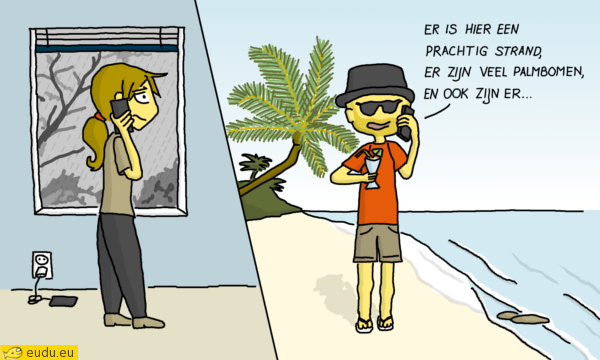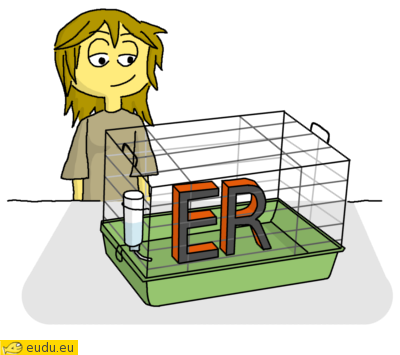How does ‘er’ work?
Er, ermee, eraan, ernaartoe, er is… ‘Er’ probably is the most difficult word of the Dutch grammar and maybe even of the entire Dutch language. Many learners of Dutch fear this word, but ‘er’ isn’t as complex as it may look. Take a look at the explaination and the animations and maybe ‘er’ appears to be a lot easier than you thought it was.

There are two kinds of er:
1. er is / er zijn: this er means: at this place or there
2. the er with a preposition: er replaces a part of the sentence
Er is / er zijn
This er means: at this place or there.
| Er zijn veel palmbomen. | = | Op deze plek zijn veel palmbomen. |
| Op zaterdag is er niemand. | = | Op zaterdag is daar niemand. |
| Er is steeds meer CO2 in de atmosfeer. | = | In de wereld is steeds meer CO2 in de atmosfeer. |
You can use zijn, verbs of position and verbs of movement.
| Er zit iemand op mijn stoel. | = | Hier (bijv. in de bioscoop) zit iemand op mijn stoel. |
| In het weekend rijden er veel minder vrachtwagens. | = | In het weekend rijden hier (of in Nederland, in Europa, ...) veel minder vrachtwagens. |
| Er staan twee mannen van de belastingdienst voor de deur | = | Daar staan twee mannen van de belastingdienst voor de deur. |
This form exists in many other languages as well:
| In polish and russian, there’s no identical form: | |

Er with a preposition
Er replaces a part of the sentence.
1. How does ‘er’ work?
| preposition + | het deze die dit dat |
= er + preposition |
2. Which prepositions?
met, na, om, tot and prepositions of position and movement.
(↓ show a list with the prepositions ↓)
The other prepositions never get a ‘er’.
3. Special cases
| er + met | = ermee |
| er + tot | = ertoe |
Only when it’s a movement:
| er + naar | = ernaartoe of erheen |
| er + van (afkomst) er + uit |
= ervandaan |
| er + van (naar beneden) | = ervanaf |
| er + over | = eroverheen |
Compare these two sentences:
4. The position of 'er'
Er comes right after:
| the subject | , | the verb and | the indirect object. |
|---|---|---|---|
| onderwerp 1st case nominative |
werkwoord verbum | meewerkend voorwerp dative 3rd case |
Does er stand right in front of a preposition? Than we wright er and the preposition together as one word. If there are words between er and the preposition, than er is written seperately.

And? Are you still afraid of ‘er’?
